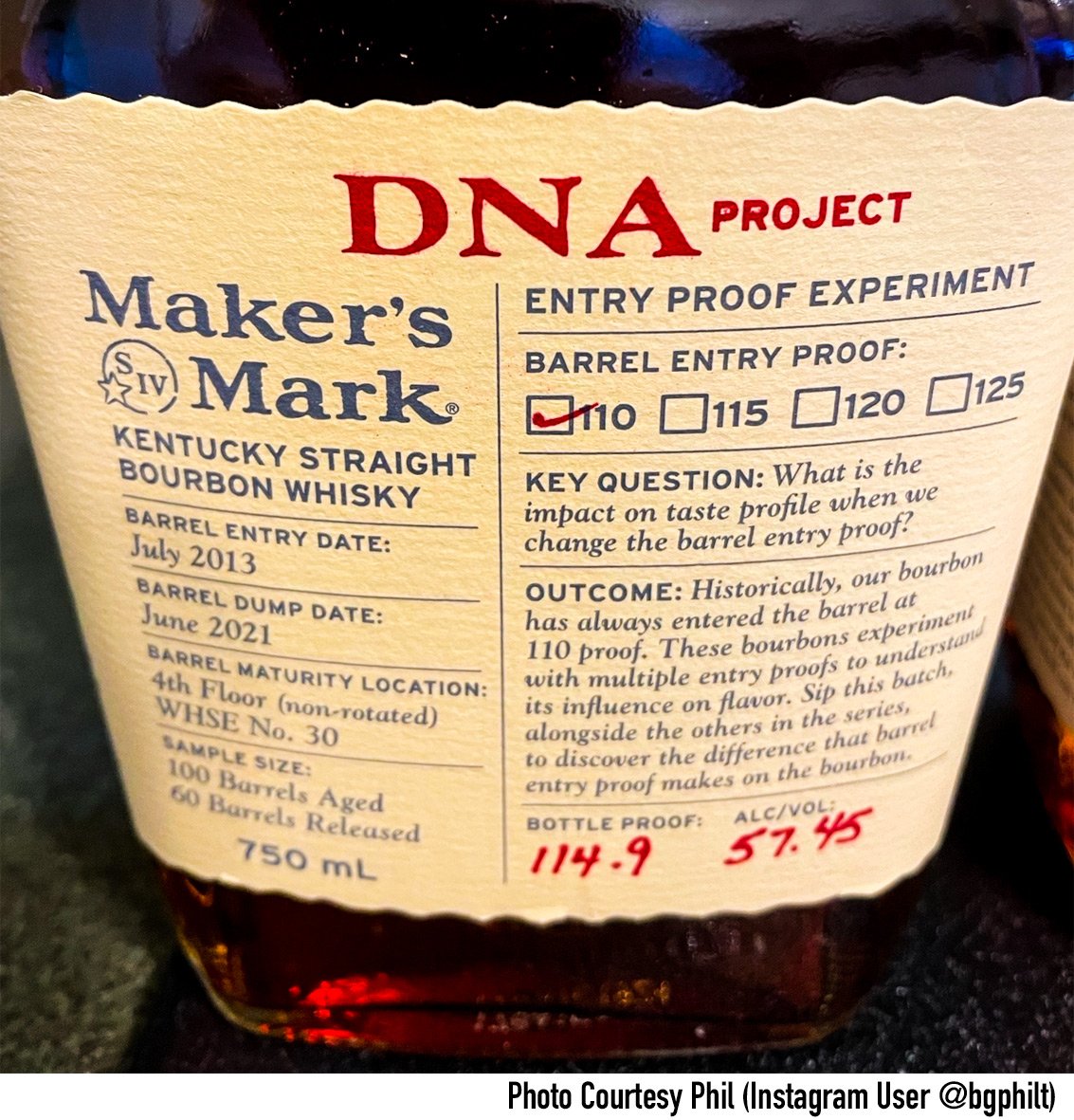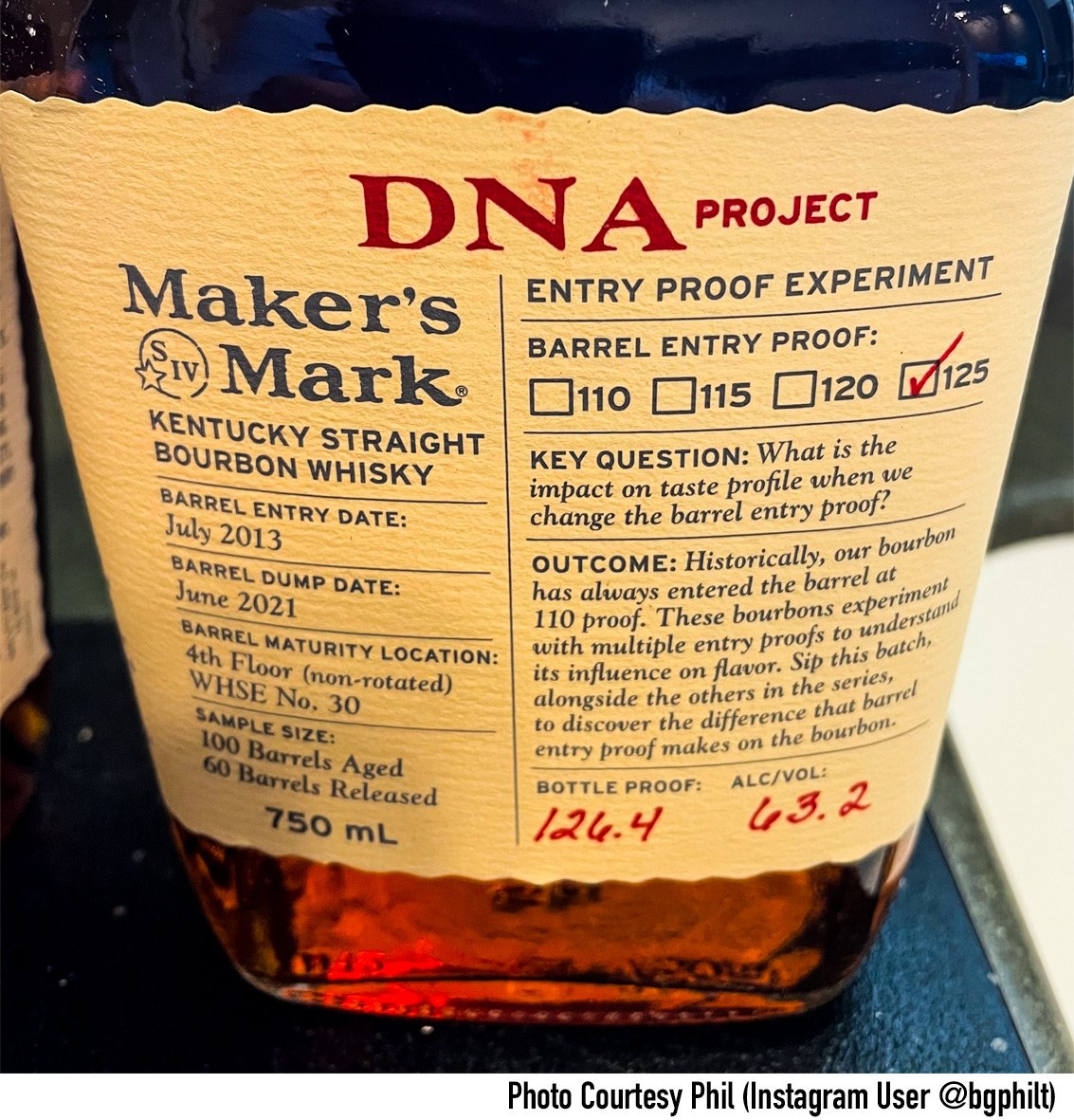I’d like to tell you a tale. It is a tale most harrowing and yet most satisfying. It is a tale of joy, heartbreak, danger, and fun. And it begins thusly:
Ahem. Sorry about that. Kinda got carried away channeling my inner Dungeon Master there.
Anyway, about three weeks ago, I reviewed a sample from Maker’s Mark that was intended to highlight why they have continued to use a 110° proof barrel-entry proof in spite of a majority of their competitors using the maximum allowed barrel-entry proof of 125° proof. In that article, I stated:
The lower entry proof that Maker’s Mark employs (110° proof) is one of the elements that Maker’s thinks make them special. And maybe it does. I have yet to taste a Maker’s product using the industry standard 125° entry proof, so I don’t know.
Well, that statement inspired one of your fellow readers to reach out to me. He is a member of the Maker’s Mark Whiskey Drop Club (and if you live in Kentucky, Nebraska, North Dakota, or Washington, D.C., you can get on the waitlist for this club at the Maker’s Mark website). Apparently, in December 2021 and February 2022, the drops were of something called the Maker’s Mark DNA Project. A series of four bottles of cask-strength Maker’s Mark. The difference between each bottle was the barrel-entry proof of the distillate. December 2021 included one bourbon that was entered into the barrel at 110° proof, and another entered at 115° proof. The February 2022 shipment included bourbons entered at 120° proof and 125° proof.
So Phil (@bgphilt on both Instagram and Twitter), being both an avid reader of BourbonGuy.com—I assume—and a member of the Whiskey Drop Club, reached out to me to offer me the opportunity to taste samples of these four bourbons that Maker’s Mark released to show you why they stick with a barrel-entry proof of 110° proof even though it is more expensive to use that lower-proof distillate to fill their barrels. I happily accepted, and he sent me a small sample of each. This is the joy I spoke of above.
The heartbreak comes when I tell you that as I was taking a photo of the samples for the lead photo of this article, I knocked the 115° proof version off of the deck railing and onto the cement patio 13 feet below. Shattering the bottle and sending whiskey and broken glass across my grilling area. That is the heartbreak and the danger I spoke of. (I mean, come on. I was in serious danger of poking my finger as I cleaned it up. It may have even made me bleed my own blood.)
Now onto the fun. I still had the most important samples left. If I needed to destroy one on my way to happiness, the 115 was the least important to discovering the difference between the Maker’s 110° proof entry and what would happen if they used the industry-standard 125° proof. And so I set out to do tastings of the three remaining at cask strength, take formal tasting notes of them, and then dilute them all to the standard Maker’s Mark proof of 90° proof and see what the alternate realities would be like where Maker’s decided to switch to either 120° or 125° proof for barrel entry. And I’m going to include photos of bottle shots and explanatory posters that Phil was kind enough to send photos of as well. So dig in. Here we go.
From the bottle labels (same text on each aside from the entry proof and the bottling proof):
Key Question: What is the impact on taste profile when we change the barrel entry proof?
Outcome: Historically, our bourbon has always entered the barrel at 110 proof. These bourbons experiment with multiple entry proofs to understand its influence on flavor. Sip this batch, alongside the others in the series, to discover the difference that barrel entry proof makes on the bourbon.
For this project, the variables were all the same aside from the initial barreling proof and the final bottling proof. As such I’ll list the variables that remained constant here:
Details: Barrel Entry Date: July 2013. Barrel Dump Date: June 2021. Barrel Maturity Location: 4th Floor (non-rotated), Warehouse No. 30. Sample Size: 100 Barrels Aged, 60 Barrels Released.
Maker’s Mark DNA Project: 110 Proof Barrel Entry
From the Poster:
OUR TASTE VISION: When Bill and Margie Samuels started crafting our iconic whisky, they wanted a refined flavor-forward spirit they could share with friends. A whisky with less bite. Their original taste vision started with our soft red winter wheat, creating a more delicate distillate and rounded mouthfeel. And, it was this distillate that would enter the barrel at 110 proof and later become what we know today as Maker's Mark.®
Bill and Margie wanted to make something they'd be proud to put their mark on, a new kind of bourbon experience that was full-flavored and inviting, one that brought "good taste" to "tastes good."
Through ingenuity, patience and a determined taste vision, Bill not only reinvented the family whisky, he and his collaborator—Margie—also revolutionized an industry.
This experiment was conducted to validate choices made in 1953 on how to best craft our whisky. Those choices were made without the modern amenities we have today.
Details: Barrel Entry ABV: 55% ABV. Bottling ABV: 57.45% ABV.
Nose: Toffee, Vanilla, red fruit, bubblegum, and almond.
Mouth: Cinnamon, toffee, almond, oak, and a touch of vanilla.
Finish: Warm and on the longer side of medium. Notes of vibrant cinnamon, dark chocolate, and oak linger.
Maker’s Mark DNA Project: 115 Proof Barrel Entry
From the Poster:
A BARREL-ENTRY PROOF HISTORY: No Kentucky bourbon can be distilled above 125 proof. This became law in 1962 for whiskies qualifying as Straight
Bourbon Whisky. The proof limit didn't just lighten the flavor. It also decreased the number of barrels used, seeing as you can only use barrels one time. At 125 proof, it would take eight years to achieve the flavor of products that were produced at proofs post-Prohibition between 100-110 proof.
This was just about a decade after Bill Samuels, Sr., laid down the first Maker's Mark barrels using the entry proof of 110. In the 1980s, 125 proof became standard in practice and widely adopted by distillers. At Maker's Mark, we opted to keep that low barrel proof as part of our commitment to honor our original taste vision.
To understand our flavor journey, our DNA projects use modern methods of analytics to explore the decisions made by our founders during the early development of our whisky.
Barrel entry proofs tested: 110, 115, 120 and 125.
We can produce really good whisky at other proofs, but they are not Maker’s. Our 110 Barrel Entry Proof held up best as it did in 1953.
Details: Barrel Entry ABV: 57.5% ABV. Bottling ABV: 58.8% ABV.
Tasting notes: are unavailable as I am a klutz and destroyed the sample before tasting. I’m pretty sure it was delicious, though.
Maker’s Mark DNA Project: 120 Proof Barrel Entry
From the Poster:
THE CONCLUSION: This is a combination of scientific analysis overlayed with our team’s sensory notes for each liquid. The graph shows how the flavors work together. They are not individual.
Details: Barrel Entry ABV: 60% ABV. Bottling ABV: 61.4% ABV.
Nose: This will sound weird, but the initial note I get is the smell of warm sunshine hitting a hay field. Other notes include mint, cocoa, cinnamon, and oak.
Mouth: Spicy with notes of cinnamon, cola, ginger, and oak.
Finish: Long and warm with notes of cinnamon, ginger, caramel, and tannic oak.
Maker’s Mark DNA Project: 125 Proof Barrel Entry
From the Poster:
THE CONCLUSION: After reviewing the results, we found that entry proof had a material impact on the bourbon taste. After eight years of working on this project, we realized that entry proof is way more impactful to your whisky than we could have imagined. While the flavors created in the alternate proofs are unique, they weren't the original taste vision of our founders, and so we determined we needed to retain an entry proof into the barrel of 110 even though it yields less mature volume that a higher original entry proof.
In conclusion, with the science and analytics available today, we were able to reaffirm the decision to enter the barrel at 110 proof made by Bill Samuels, Sr., in 1953.
While we are pleased to share these with you in experimental form, we will never alter our barrel entry proof. The Samuels family had it right from the start.
Details: Barrel Entry ABV: 62.5% ABV. Bottling ABV: 63.2% ABV.
Nose: The first thing that jumps out at me is oak. Past that, I'm finding ginger and caramel.
Mouth: Hot. Brown sugar, tannic oak, cinnamon, ginger, and red fruit.
Finish: Sweet, hot, and long. Notes of cola, ginger, and tannic oak.
Impressions on samples cut to 90° proof
Nose: 120 shows much more sweetness and mint than 110. 125 is a lot like 110. 120 is the outlier.
Mouth: There is a subtle difference between 110 and 120 at this proof. 120 is showing more oak influence. 125 shows even more oak influence. It's the most tannic of the three. It also brings more sweetness and spice than the other two. That oak influence continues into the finish.
Thoughts: Of the three, I think that the 110° proof is my favorite when diluted to the standard bottle proof. 125 is my wife's favorite. She really likes some oak influence, though. 120 and 125 are similar at this proof though we both agreed that 120 was the clear number three of the group.
Final Thoughts
This was such a fun exploration! I love when companies allow fans to explore how changing one variable in how you make whiskey affects things. In this case, upping the barrel entry proof seems to have extracted more tannic oak notes. It also seems to have accentuated the spicy notes allowing more ginger and cola to come to the forefront as the barrel-entry proof increased. Trying these at full proof, I have to say that 120 is my favorite of the three (125 is my wife's), but neither of them tastes like Maker's Mark. I totally understand why they don't want to change things up.
Thanks again to Phil (@bgphilt on Twitter and Instagram) for sending these samples along. I hope he had as much fun reading this as I did tasting these.
Did you enjoy this post? If you want to support the work going on here at BourbonGuy.com, please consider a one-time donation at ko-fi.com/bourbonguy or buying some merch at BourbonGuyGifts.com.










